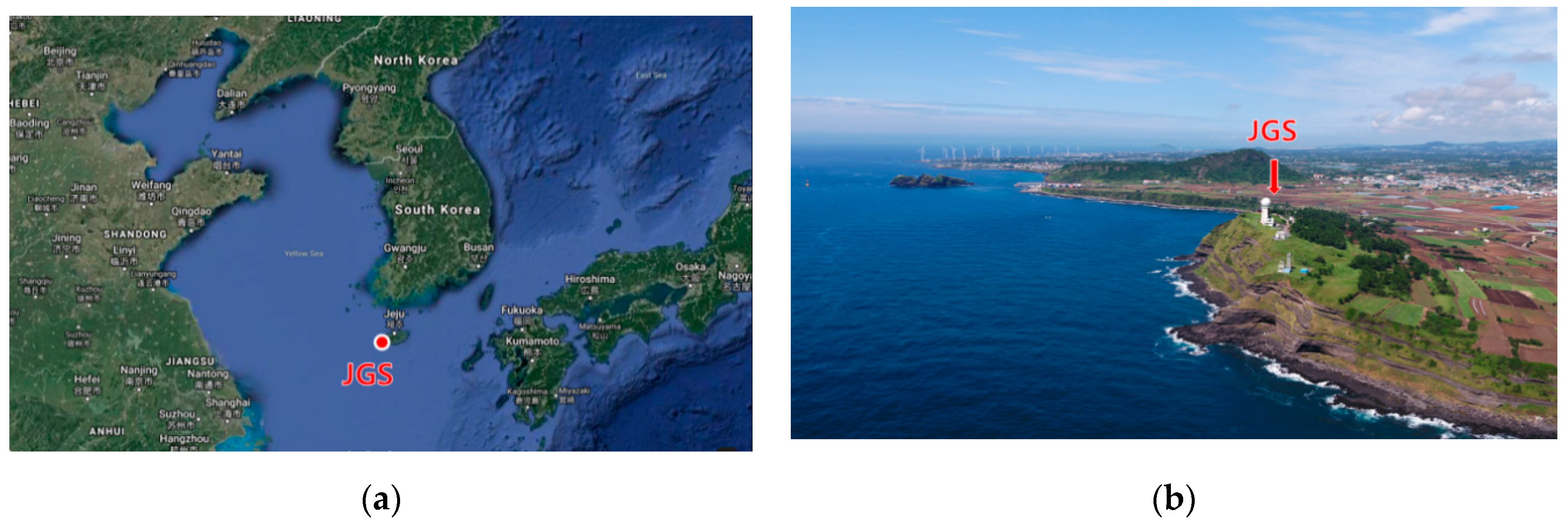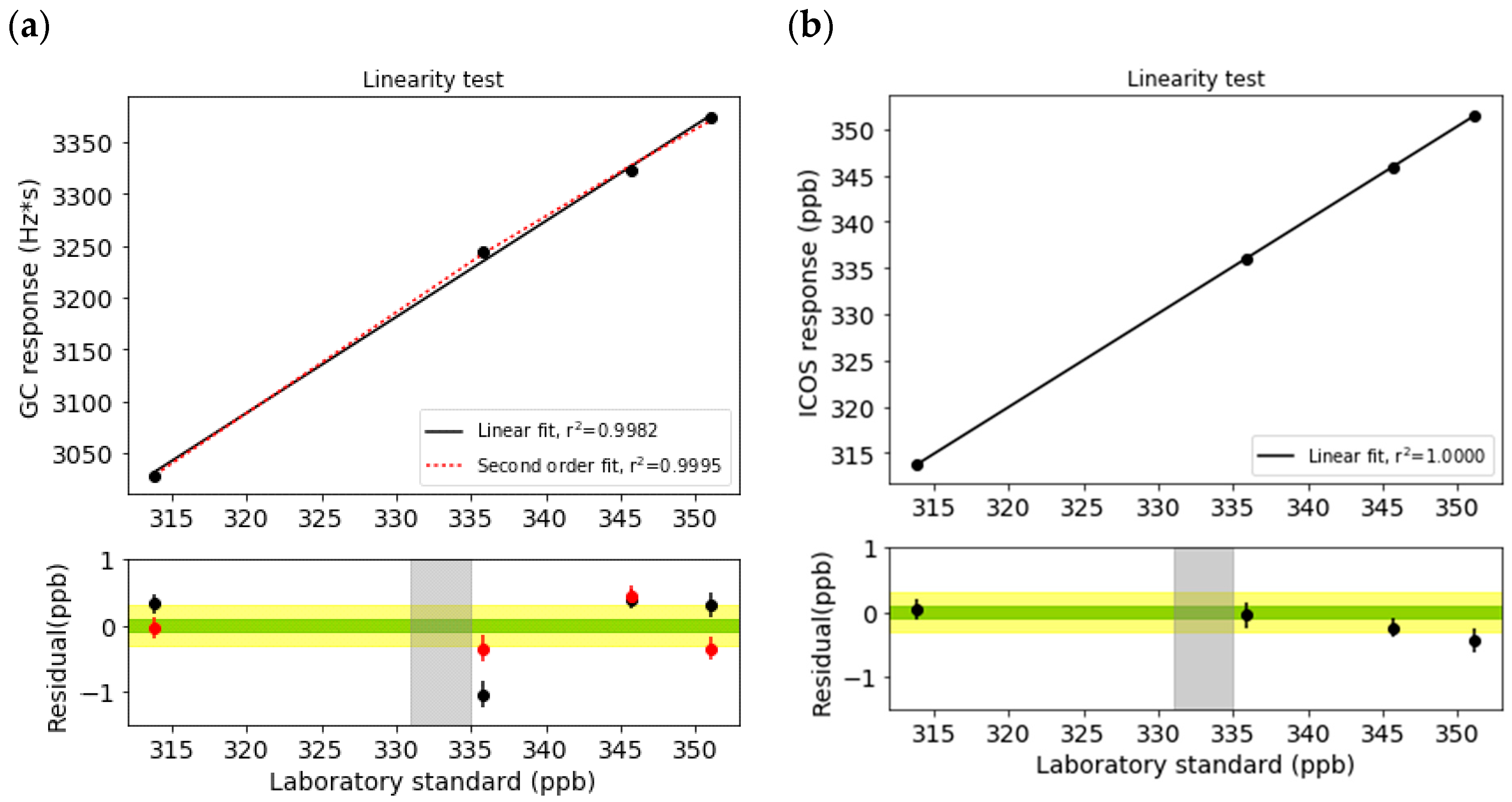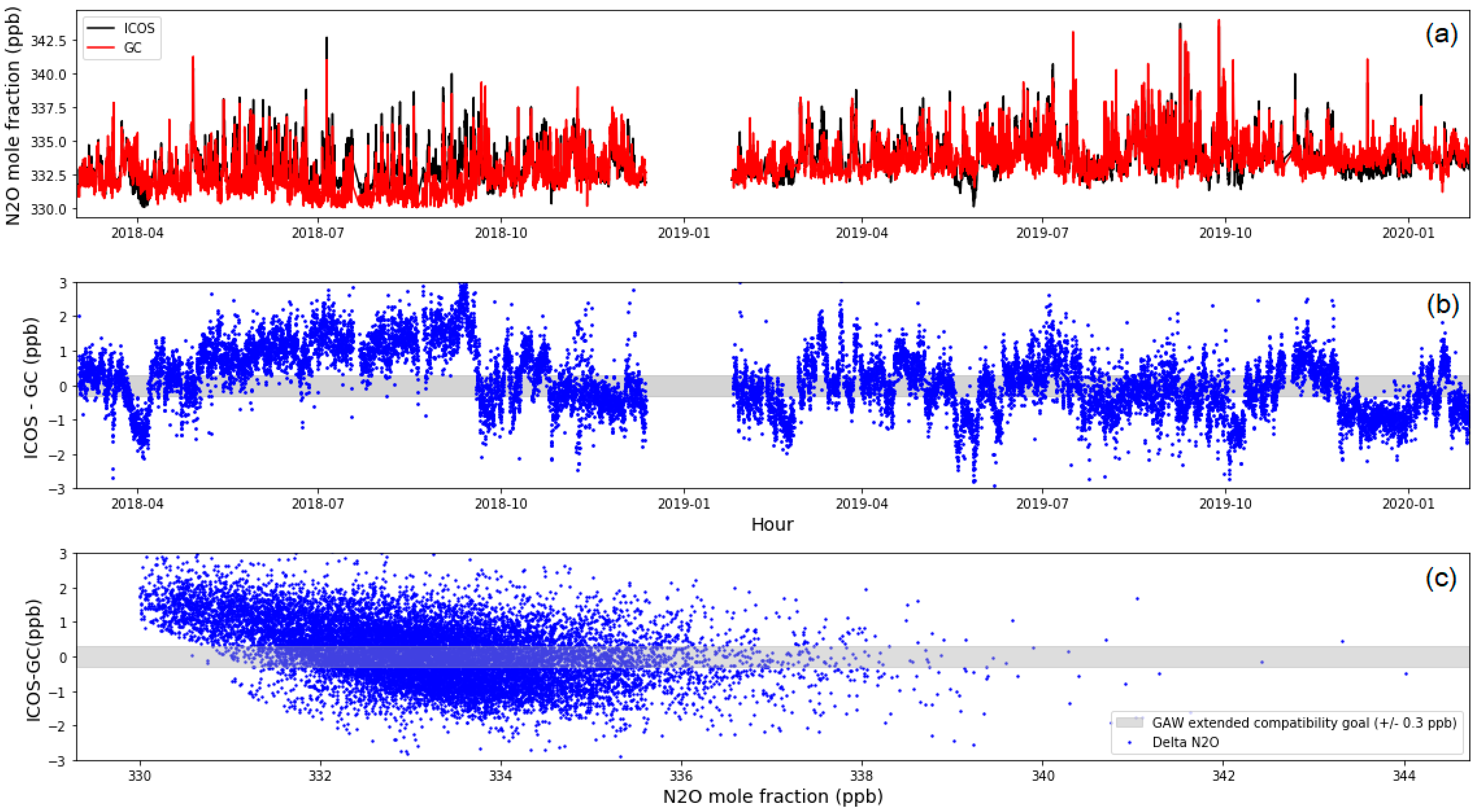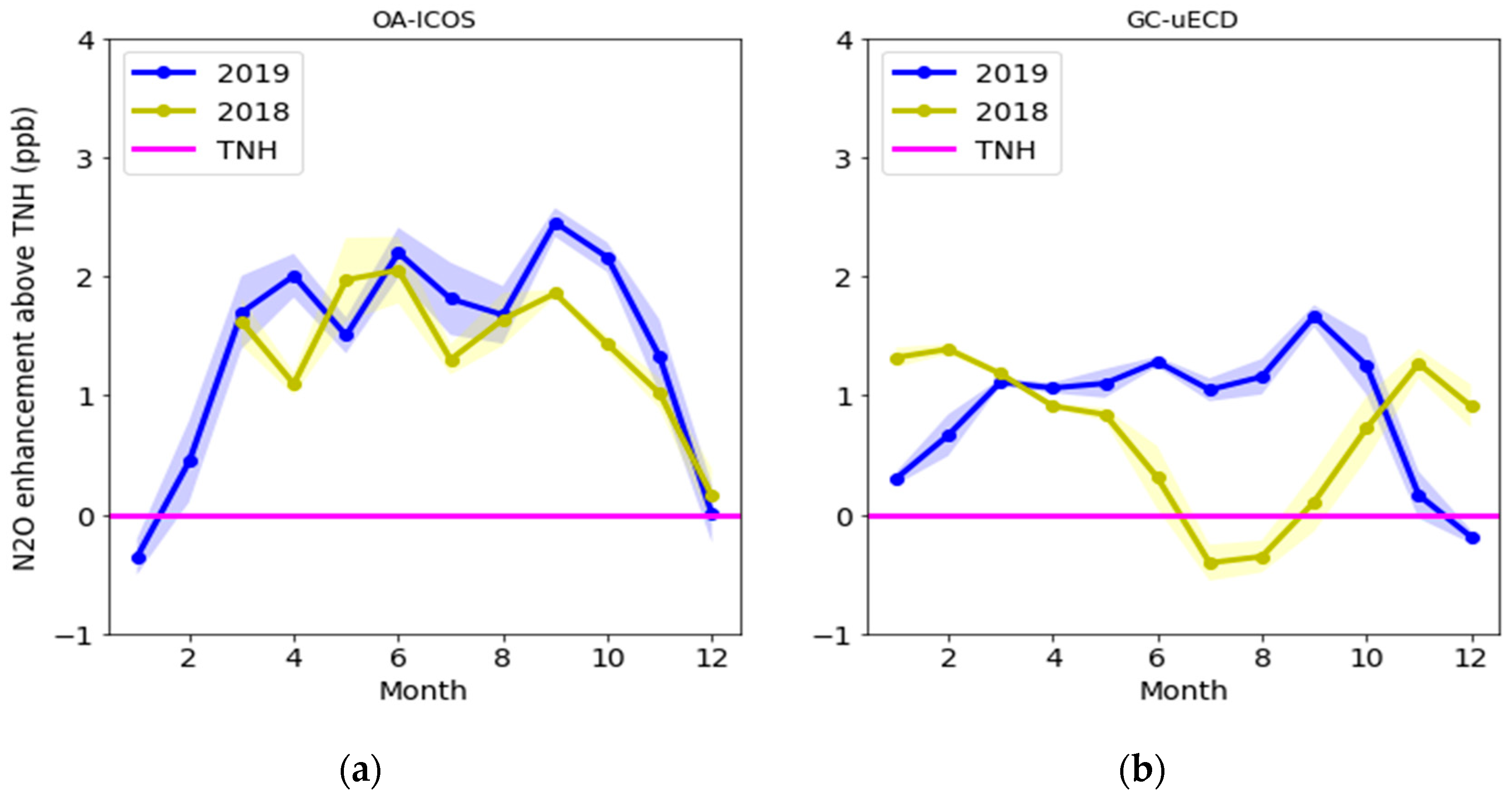Comparison of GC-μECD and OA-ICOS Methods for High-Precision Measurements of Atmospheric Nitrous Oxide (N2O) at a Korean GAW Station
Abstract
:1. Introduction
2. Sampling Site and Measurement System
2.1. Sampling Site
2.2. Measurement System
3. Analysis Method of Measurement Uncertainty Factors
3.1. Linearity
3.2. Repeatability
3.3. Reproducibility
4. Results and Discussion
4.1. Measurement Uncertainties
4.2. Inter-Comparison Experiment between OA-ICOS and the GC-μECD
4.3. Enhancement N2O Values
5. Conclusions
Author Contributions
Funding
Acknowledgments
Conflicts of Interest
References
- Butler, H.J.; Montzka, S.A. Annual Greenhouse Gas Index, NOAA. Available online: https://www.esrl.noaa.gov/gmd/aggi/aggi.html (accessed on 1 August 2020).
- Myhre, G.; Shindell, D.; Bréon, F.-M.; Collins, W.; Fuglestvedt, J.; Huang, J.; Koch, D.; Lamarque, J.-F.; Lee, D.; Mendoza, B.; et al. Anthropogenic and Natural Radiative Forcing. In Climate Change 2013: The Physical Science Basis. Contribution of Working Group I to the Fifth Assessment Report of the Intergovernmental Panel on Climate Change; Stocker, T.F., Qin, D., Plattner, G.-K., Tignor, M., Allen, S.K., Boschung, J., Nauels, A., Xia, Y., Bex, V., Midgley, P.M., Eds.; Cambridge University Press: Cambridge, UK; New York, NY, USA, 2013. [Google Scholar]
- Prather, M.J.; Holmes, C.D.; Hsu, J. Reactive greenhouse gas scenarios: Systematic exploration of uncertainties and the role of atmospheric chemistry. Geophys. Res. Lett. 2012, 39, L09803. [Google Scholar] [CrossRef] [Green Version]
- Crutzen, P.J. The influence of nitrogen oxides on the atmospheric ozone content. Q. J. Roy. Meteorol. Soc. 1970, 96, 320–325. [Google Scholar] [CrossRef]
- Ravishankara, A.R.; Daniel, J.S.; Portmann, R.W. Nitrous Oxide (N2O): The Dominant Ozone-Depleting Substance Emitted in the 21st Century. Science 2009, 326, 123–125. [Google Scholar] [CrossRef] [Green Version]
- Firestone, M.K.; Davidson, E.A. Microbiological basis of NO and N2O production and consumption in the soil. In Exchange of Trace Gases between Terrestrial Ecosystems and the Atmosphere; Andreae, M.O., Schimel, D.S., Eds.; Wiley and Sons: Chichester, UK, 1989; pp. 7–21. [Google Scholar]
- Elkins, J.W.; Wofsy, S.C.; McElroy, M.B.; Kolb, C.E.; Kaplan, W.A. Aquatic sources and sinks for nitrous oxide. Nature 1978, 275, 602–606. [Google Scholar] [CrossRef]
- Cohen, Y.; Gordon, L.I. Nitrous oxide production in the Ocean. J. Geophys. Res. 1979, 84, 347–353. [Google Scholar] [CrossRef]
- Seitzinger, S.P.; Kroeze, C. Global distribution of nitrous oxide production and N inputs in freshwater and coastal marine ecosystems. Glob. Biogeochem. Cy. 1998, 12, 93–113. [Google Scholar] [CrossRef]
- Beaulieu, J.J.; Tank, J.L.; Hamilton, S.K.; Wollheim, W.M.; Hall, R.O.; Mulholland, P.J.; Peterson, B.J.; Ashkenas, L.R.; Cooper, L.W.; Dahm, C.N.; et al. Nitrous oxide emission from denitrification in stream and river networks. Proc. Natl. Acad. Sci. USA 2011, 108, 214–219. [Google Scholar] [CrossRef] [PubMed] [Green Version]
- Combined Nitro Oxide Data from the NOAA/ESRL Global Monitoring Laboratory. Available online: esrl.noaa.gov/gmd/hats/combined/N2O.html (accessed on 2 September 2020).
- Galloway, J.N.; Townsend, A.R.; Erisman, J.W.; Bekunda, M.; Cai, Z.C.; Freney, J.R.; Martinelli, L.A.; Seitzinger, S.P.; Sutton, M.A. Transformation of the nitrogen cycle: Recent trends, questions, and potential solutions. Science 2008, 320, 889–892. [Google Scholar] [CrossRef] [Green Version]
- Davidson, E.A. The contribution of manure and fertilizer nitrogen to atmospheric nitrous oxide since 1860. Nat. Geosci. 2009, 2, 659–662. [Google Scholar] [CrossRef]
- Park, S.; Croteau, P.; Boering, K.A.; Etheridge, D.M.; Ferretti, D.; Fraser, P.J.; Kim, K.R.; Krummel, P.B.; Langenfelds, R.L.; van Ommen, T.D.; et al. Trends and seasonal cycles in the isotopic composition of nitrous oxide since 1940. Nat. Geosci. 2012, 5, 261–265. [Google Scholar] [CrossRef]
- Saikawa, E.; Prinn, R.G.; Dlugokencky, E.; Ishijima, K.; Dutton, G.S.; Hall, B.D.; Langenfelds, R.; Tohjima, Y.; Machida, T.; Manizza, M.; et al. Global and regional emissions estimates for N2O. Atmos. Chem. Phys. 2014, 14, 4617–4641. [Google Scholar] [CrossRef] [Green Version]
- Wells, K.C.; Millet, D.B.; Bousserez, N.; Henze, D.K.; Griffis, T.J.; Chaliyakunnel, S.; Dlugokencky, E.J.; Saikawa, E.; Xiang, G.; Prinn, R.G.; et al. Top-down constraints on global N2O emissions at optimal resolution: Application of a new dimension reduction technique. Atmos. Chem. Phys. 2018, 18, 735–756. [Google Scholar] [CrossRef] [Green Version]
- Rapson, T.D.; Darcres, H. Analytical techniques for measuring nitrous oxide. TrAC-Trend. Anal. Chem. 2014, 54, 65–74. [Google Scholar] [CrossRef] [Green Version]
- Lebegue, B.; Schmidt, M.; Ramonet, M.; Wastine, B.; Kwok, C.Y.; Laurent, O.; Belviso, S.; Guemri, A.; Philippon, C.; Smith, J.; et al. Comparison of nitrous oxide (N2O) analyzers for high-precision measurements of atmospheric mole fraction. Atmos. Meas. Tech. 2016, 9, 1221–1238. [Google Scholar] [CrossRef] [Green Version]
- Lee, H.; Han, S.-O.; Ryoo, S.-B.; Lee, J.-S.; Lee, G.-W. The measurement of atmospheric CO2 at KMA GAW regional stations, its characteristics, and comparisons with other East Asian sites. Atmos. Chem. Phys. 2019, 19, 2149–2163. [Google Scholar] [CrossRef] [Green Version]
- Global Atmosphere Watch Station Information System. Available online: http://gawssis.meteoswiss.ch (accessed on 25 July 2020).
- Zellweger, C.; Steinbrecher, R.; Laurent, O.; Lee, H.; Kim, S.; Emmernegger, L.; Steinbacher, M. Buchmann. Amos. Meas. Tech. 2019, 12, 5863–5878. [Google Scholar] [CrossRef] [Green Version]
- Hall, B.D.; Dutton, G.S.; Mondeel, D.J.; Nance, J.D.; Rigby, M.; Butler, J.H.; Moore, F.L.; Hurst, D.F.; Elkins, J.W. Improving measurements of SF6 for the study of atmospheric transport and emissions. Atmos. Meas. Tech. 2011, 4, 2441–2451. [Google Scholar] [CrossRef] [Green Version]
- Lim, J.S.; Lee, J.-B.; Moon, D.M.; Kim, J.S.; Lee, J.-S.; Hall, B.D. Gravimetric standard gas mixtures for global monitoring of atmospheric SF6. Anal. Chem. 2017, 89, 12068–12075. [Google Scholar] [CrossRef]
- Rao, G.N.; Karpf, A. Extremely sensitive detection of NO2 employing off-axis integrated cavity output spectroscopy coupled with multiple-line integrated absorption spectroscopy. Appl. Opt. 2011, 50, 1915–1924. [Google Scholar] [CrossRef]
- Hall, B.D.; Dutton, G.S.; Elkins, J.W. The NOAA nitrous oxide standard scale for atmospheric observations. J. Geophys. Res. 2007, 112, D09305. [Google Scholar] [CrossRef]
- WCC-Empa. System and Performance Audit of Surface Ozone, Carbon Monoxide, Methane, Carbon Dioxide and Nitrous Oxide at the Regional GAW Station Jeju-Gosan Republic of Korea; WCC-Empa Report 17/2; WCC-Empa: Duebendorf, Switzerland, 2017; p. 42. [Google Scholar]
- Stanley, K.M.; Grant, A.; O’Doherty, S.; Young, D.; Manning, A.J.; Stavert, A.R.; Spain, T.G.; Salameh, P.K.; Harth, C.M.; Simmonds, P.G.; et al. Greenhouse gas measurements from a UK network of tall towers: Technical description and first results. Atmos. Meas. Tech. 2018, 11, 1437–1458. [Google Scholar] [CrossRef] [Green Version]
- Lopez, M.; Schmidt, M.; Yver, C.; Messager, C.; Worthy, D.; Kazan, V.; Ramonet, M.; Bousquet, P.; Ciais, P. Seasonal variation of N2O emissions in France inferred from atmospheric N2O and Rn-222 measurements. J. Geophys. Res.-Atmos. 2012, 117, D14103. [Google Scholar] [CrossRef]
- Nevison, C.D.; Dlugokencky, E.; Dutton, G.; Elkins, J.W.; Fraser, P.; Hall, B.; Krummel, P.B.; Langenfelds, R.L.; O’Doherty, S.; Prinn, R.G.; et al. Exploring causes of interannual variability in the seasonal cycles of tropospheric nitrous oxide. Atmos. Chem. Phys. 2011, 11, 3713–3730. [Google Scholar] [CrossRef] [Green Version]
- Popa, M.E.; Gloor, M.; Manning, A.C.; Jordan, A.; Schultz, U.; Haensel, F.; Seifert, T.; Heimann, M. Measurements of greenhouse gases and related tracers at Bialystok tall tower station in Poland. Atmos. Meas. Tech. 2010, 3, 407–427. [Google Scholar] [CrossRef] [Green Version]
- Lee, J.; Kim, G.; Lee, H.; Moon, D.; Lee, J.-B.; Lim, J.-S. Comparative study of various methods for trace SF6 measurement using GC-μECD: Demonstration of lab-pressure-based drift correction by preconcentrator. JTECH 2020, 37, 901–910. [Google Scholar] [CrossRef]
- Thoning, K.W.; Tans, P.P.; Komhyr, W.D. Atmospheric Carbon dioxide at Mauna Loa Observatory 2. Analysis of the NOAA GMCC Data, 1984–1985. J. Geophys. Res. 1989, 94, 8549–8565. [Google Scholar] [CrossRef]




| GC-μECD (Agilent 7890A) | |
| Sample loop | 5 mL |
| Column | Main: Porapak-Q (Restek, PA, USA), 80/100 mesh, 12 ft, 2.0 mm Interior Diameter (I.D.), 1/8”Outside Diameter (O.D.) Post: Porapak-Q (Restek, PA, USA), 80/100 mesh, 6 ft, 2.0 mm I.D., 1/8” O.D. |
| Oven Temp. | 60 °C |
| Detector Temp | 375 °C |
| Carrier gas flow rate (P5, CH4 5% in Ar) | Main: 45 psi Post: 42 psi |
| Make-up flow rate | 5 mL/min |
| Sample flow rate | 100 mL/min |
| OA-ICOS (Los Gatos EP-30) | |
| Cell size | 434 mL |
| Cell pressure | 85 ± 0.1 Torr |
| Cell temperature | 45 ± 0.005 °C |
| Sample flow | 300 mL/min |
| Uncertainty Factors | Analyzer | ||
|---|---|---|---|
| OA-ICOS | GC-μECD | Relevant Equation | |
| Ur (second-order polynomial) | 0.35 | 0.85 (0.48) | Section 3.1 Equation (1) |
| Up | 0.03 | 0.26 | Section 3.2 Equation (2) |
| UL | 0.46 | 1.19 | Section 3.3 Equation (3) |
© 2020 by the authors. Licensee MDPI, Basel, Switzerland. This article is an open access article distributed under the terms and conditions of the Creative Commons Attribution (CC BY) license (http://creativecommons.org/licenses/by/4.0/).
Share and Cite
Lee, H.; Ko, M.; Kim, S.; Seo, W.; Park, Y.-S. Comparison of GC-μECD and OA-ICOS Methods for High-Precision Measurements of Atmospheric Nitrous Oxide (N2O) at a Korean GAW Station. Atmosphere 2020, 11, 948. https://doi.org/10.3390/atmos11090948
Lee H, Ko M, Kim S, Seo W, Park Y-S. Comparison of GC-μECD and OA-ICOS Methods for High-Precision Measurements of Atmospheric Nitrous Oxide (N2O) at a Korean GAW Station. Atmosphere. 2020; 11(9):948. https://doi.org/10.3390/atmos11090948
Chicago/Turabian StyleLee, Haeyoung, Miyoung Ko, Sumin Kim, Wonick Seo, and Young-San Park. 2020. "Comparison of GC-μECD and OA-ICOS Methods for High-Precision Measurements of Atmospheric Nitrous Oxide (N2O) at a Korean GAW Station" Atmosphere 11, no. 9: 948. https://doi.org/10.3390/atmos11090948
APA StyleLee, H., Ko, M., Kim, S., Seo, W., & Park, Y.-S. (2020). Comparison of GC-μECD and OA-ICOS Methods for High-Precision Measurements of Atmospheric Nitrous Oxide (N2O) at a Korean GAW Station. Atmosphere, 11(9), 948. https://doi.org/10.3390/atmos11090948





